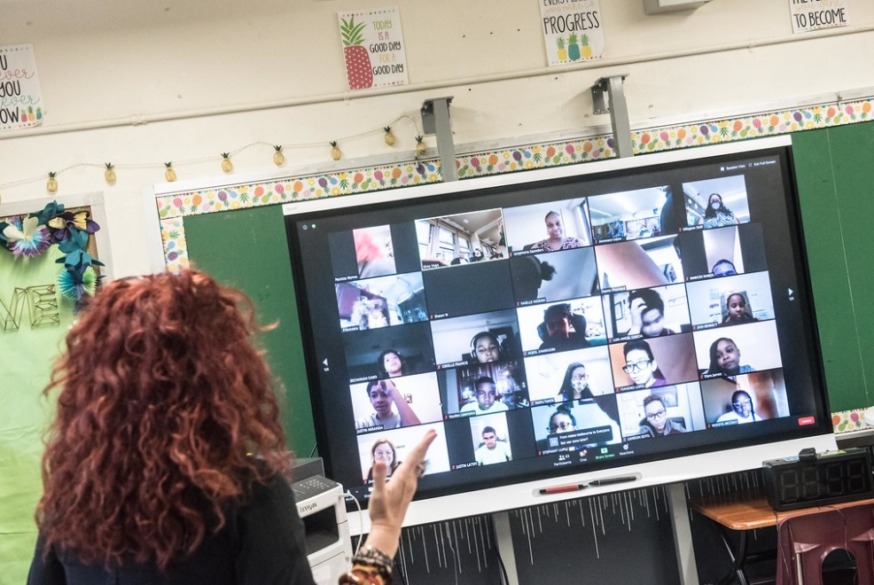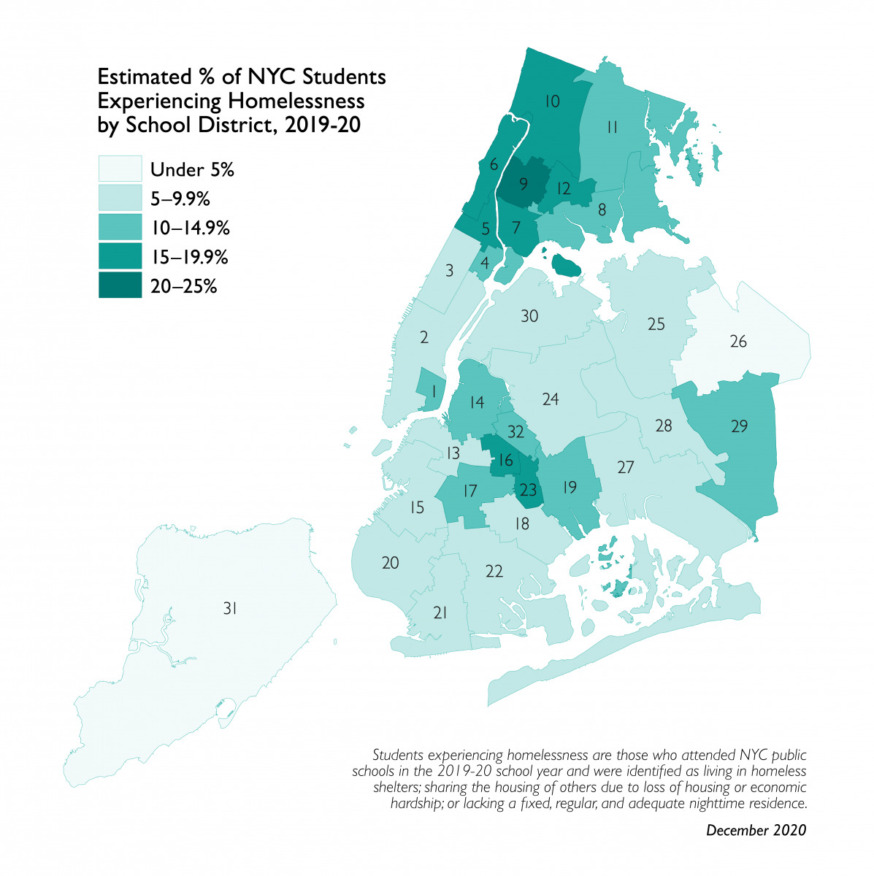
(Michael Appleton/Mayoral Photography Office)
Dec. 6, 2020 By Allie Griffin
More than 21,000 public school and charter school children in Queens had no permanent home last school year, according to a report released Thursday.
The children represented about 20 percent of the roughly 111,000 students citywide who were homeless during the 2019-2020 school year, according to a report released by the Advocates for Children of New York (AFC) that analyzed data from the New York State Education Department.
In Queens, 21,266 students experienced homelessness and they lived in a variety of temporary locations. According to the report, 16,473 were doubled-up in the home of a relative or friend; 3,978 were living in shelters; 755 students were living in cars, parks, campgrounds, temporary trailers or abandoned buildings; and 60 were living in a hotel or motel.
The level of homeless was more pronounced in some school districts than others.
School District 24 — which includes schools in Ridgewood, Maspeth, Glendale, Middle Village, Elmhurst, Corona, and parts of Woodside, Long Island City and Sunnyside — had the highest number of homeless students in Queens, with 5,593 students. In terms of student numbers, it ranked third in New York City, behind School Districts 9 and 10 in the Bronx.
Other Queens districts also had thousands of students who were homeless. School District 30–which covers Jackson Heights, Astoria, East Elmhurst and parts of Sunnyside, Woodside and Long Island City– had 3,084 students deemed homeless.
Meanwhile, School District 25 had 2,105 homeless students; School District 26 accounted for 1,147 homeless students; School District 27 had 2,917 students who were homeless; and School District 28 had 2,838.
School District 29 — which includes schools in Jamaica, Cambria Heights, Hollis, Springfield Gardens, St. Albans, Laurelton, Queens Village and Rosedale — had 2,905 homeless students. However, the district, based on its student population, had the highest percentage of homeless students among Queen Districts. Between 10 and 14.9 percent of students in District 29 were homeless, according to the report.

(Advocates for Children of New York)
The number of New York City students experiencing homelessness has surpassed 100,000 for the fifth consecutive year and about 85 percent of those students are Black or Hispanic, according to AFC.
Students who face homeless are always at a significant disadvantage compared to their peers when it comes to learning. However, in the past year it has been even more pronounced, since remote learning has become a feature of public school and students need computers and internet access.
Many homeless students struggle to get access to a working computer, and they often find it difficult to find a quiet room where they can learn. Many homeless students, according to the report, are often forced to complete assignments on a smartphone in the middle of a noisy and overcrowded room.
“Learning from home is much harder when you don’t have a permanent home,” said Kim Sweet, Executive Director of AFC. “The City must ensure that every student who is homeless has the technology and support they need during this period of remote and hybrid learning.”
Many children who live in shelters have been provided with a DOE-issued iPad. However, often the buildings they are in lack adequate Wi-Fi and cell reception needed to use them, according to the AFC report. Additionally, some children in shelters have yet to receive a device.
The number of city students without a home is likely to rise when the state’s moratorium on evictions expires on Jan. 1, Sweet warns. She notes that the number is far too large as it is.
“The vast scale of student homelessness in New York City demands urgent attention,” she said. “If these children comprised their own city, it would be larger than Albany, and their numbers may skyrocket even further after the state eviction moratorium is lifted.”
AFC is calling on City Hall to provide more support for homeless students to ensure every student has the technology needed to participate in remote learning.
42 Comments






When will adults that are already poor or in poverty realize that having children is an 18 year long bill that gets more expensive every year. You know what is not going to help your already low income situation? Having children.
This made me cry so much because I am a college student living in a single parent household. Poverty is horrible in our area and that is why I have not quit school. My grandparents risked it all coming to this country to provide us a better life. I thank God each day for my blessing.
Help the homeless in our neighborhood! People are starving and living on the streets while rentals are remaining vacant. Either have a rent freeze or encourage landlords to house the poor by providing them with home maintenance and cost discounts. We all should have shelter and food.
What is the story of how/why did they wind up homeless?
None of your business.
I remember going to local retail store to fix my phone and I saw a kid using a tablet inside the store sitting on the floor doing his homework. Now I wonder if he was homeless or just the owners son. Its so sad.
At least he’s doing it. Gid bless him and everyone who tries every day to log on.
Enough to make a grown man cry.
If all restaurants near shelters like Chinese take out and pizza and friend chicken places unlocked their WiFi, it could help them!
For the love of all humans, PLEASE, any and all ISPs, uncap data during the pandemic period.
The percentage is much higher if you include the people and families who are or about to face eviction. I blame landlords 100 percent who want to push out the poor, add a new fridge to their rental and try to get top dollar from young privileged white people who come here because there is a bar opening on every corner.
Where is it stated that White people are the rich ones??? No one is mentioning color because homelessness doesn’t see color.
The DOE has been promising us a internet enabled device since day one….
We’re still waiting…
The internet doesn’t just work automatically, you need routers and WiFi connections. Those things cost money. My students have a hard time sometimes getting on because of everyone else in the world using the internet.
Spectrum, verizon, etc. should provide free wifi to all homeless shelters.
For all the poor and homeless in shelters without wifi, public libraries are your best friend. Trust me I know from experience. They provide warmth, space and usually free internet. But in this pandemic crisis libraries are closed, so try to see if there is any spot nearby where you can feel protected from the cold and still get a WIFI signal at places like Starbucks.
maybe educators and staff can post song and dance videos like the healthcare workers did at hospitals when they had an increase in patients.
Huh? What a weird thing to fixate on.
How could that be? According to sunnysidepost ads, there should plenty of affordable housing.
Get real!
Its very important that all adults sending children to school remind them to follow social distance guidelines and wear masks.
Thank De Blasio and Cuomo!
Heartbreaking omg heartbreaking it ?????
Its is a terrible time for most of us. As an elder high risk Sunnyside resident I’m also frightened about becoming homeless. But I cannot allow despair to take a hold of me. I try to eat well, rest my body & mind, be kind and hope that things will prevail. Stay Strong! Many blessings to all..♡
This was very heartbreaking to read. May Allah help these families. Stay strong.
This brings tears to my eyes. Wish them all the best and Merry Christmas! <3
Homeless students. That doesn’t even
sound right. ?
That’s even worse.
I hope they find home in future.
“People cry not because they’re weak, it’s because they’ve been strong for so long” ~ Johnny Depp
New generation of kids will thrive further than adults…I like to see new generations develop better system in government and healthcare as well as all essential industries. Hope that they vanquish corrupted system and people. That’s my hope.
Parents telling their kids not to worry about succeeding in school because when they grow up they can just go on public assistance first!!!
Homeless kids is a phrase that shouldn’t exist ?
People should realize that if they can’t afford to take care of them, nobody else will…common sense
Well if they built more low income buildings instead of shelters this might not be such a problem. This city doesn’t want to fix homelessness, they want to shuffle them to side, or keep them in shelters. It’s pathetic. Families can live in shelters for months to years before housing is found for them. Who can live that way?
Poor kids ?
Well if a studio apartment wasn’t $2,500-$3000.00 a month we wouldn’t have to worry about this!
This is truly terrible news. Now, I must ask: Where’s Jimmy? Really? And Danny Dromm and all the “crusaders” who had time to march across the bridge to protest who knows that. When it comes to real problems they have no answers. Waiting for the usual crew to Blame the Orange Man.
Hashtagger- They’re with Bob Holden, Why do you always forget to ask Bobs whereabouts?
Bob Holden is a good man. Jimmy Van Bramer is not and neither are you.
Do They Know It’s Christmas?
The mayor converted many hotels into homeless shelters last year in Queens. The rise in homelessness is very evident in our neighborhood as we try to live our daily lives. Unemployment and the conversion of hotels into homeless shelters is also one of the reasons local food banks and community help centers are running out of food and resources in Western Queens. Homeless hotels are a waiting room so to speak for section 8 and affordable housing. There are many vacant apartments in NYC. Landlords need to lower rents allow rent vouchers the city provides these families.